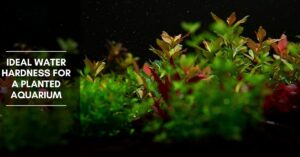Ideal Kh And Gh For Planted Aquarium
If you're trying to keep a planted aquarium, you know how important it is to have the ideal water hardness. It can be a tricky thing to get right, but it's crucial for the health and growth of your plants. In this post, we'll explore the ideal KH and GH for planted aquariums and how to achieve it.
When it comes to planted aquariums, one of the biggest pain points is maintaining the right water conditions for your plants. This can include pH, temperature, and of course, water hardness. Without the ideal KH and GH, your plants may struggle to absorb nutrients, and algae growth can become a problem. It can be a frustrating experience for aquarium enthusiasts.
The ideal KH (carbonate hardness) for a planted aquarium ranges from 3-5 degrees, while the ideal GH (general hardness) ranges from 6-8 degrees. KH is essential to stabilizing pH levels in your tank, while GH is vital for plant growth and health. Achieving the ideal hardness levels can be done through testing your water and adjusting your water source and additives accordingly.
In summary, achieving the ideal KH and GH can make all the difference in the health and growth of your planted aquarium. It's important to regularly test your water and make adjustments as necessary to maintain the proper levels.
Ideal KH and GH for Planted Aquarium and How to Achieve It
When I first started my planted aquarium, I struggled with achieving the ideal KH and GH for my plants. I found that my plants weren't growing as quickly as I had hoped, and I was battling with algae growth. Through some trial and error, I eventually found the right balance.
To achieve the ideal KH and GH levels, I first tested my water to see where it was at. I discovered that my tap water was too hard, so I started using RO (reverse osmosis) water to dilute it. I then added the appropriate additives to raise the GH to the desired range. It took some testing and adjusting, but once I got it right, my plants started to thrive.
The Importance of GH in Plants
In a planted aquarium, GH is essential for the health and growth of your plants. GH is made up of minerals such as calcium and magnesium, which are vital for plant growth, photosynthesis, and overall health. Without the appropriate GH levels, your plants can become stunted, discolored, and prone to disease.
How to Raise GH in Your Tank
If your GH levels are too low, there are a few things you can do to raise them. One option is to add GH booster to your aquarium water. This is a powdered supplement that typically contains minerals that are lacking in tap water. Another option is to add crushed coral or limestone to your aquarium substrate, as these materials can slowly raise the GH over time.
The Importance of KH in Aquariums
KH is also essential for your planted aquarium as it helps to stabilize pH levels. If the KH levels are too low, the pH can become unstable, leading to fluctuations that can stress your fish and plants. KH is also a buffer against acids, which can harm your tank's inhabitants.
Conclusion of Ideal KH and GH for Planted Aquarium
Having the ideal KH and GH levels can make all the difference in the health and growth of your planted aquarium. It's essential to test your water regularly and adjust as necessary to maintain the proper levels. With the right balance, your plants will thrive, and your aquarium will be a beautiful and healthy environment for your aquatic pets.
Question and Answer
What happens if GH is too high in a planted aquarium?
If the GH is too high in a planted aquarium, it can lead to an overabundance of nutrients in the water, which can lead to algae growth. It can also make it challenging for your plants to absorb nutrients, which can lead to stunted or discolored growth.
Can you have a planted aquarium with low KH?
While it's possible to have a planted aquarium with low KH, it can be challenging, as pH fluctuations can stress your plants and fish. It's generally recommended to have a KH of at least 3-5 degrees in a planted aquarium.
Do different plants require different GH levels?
Yes, different plants have different requirements for GH levels. Some plants, such as Anubias and Java Fern, can thrive in lower GH levels, while others, such as Amazon Swords and Vallisneria, prefer higher GH levels.
Can changing GH levels harm your fish?
Changing GH levels too quickly can be harmful to your fish, as it can cause stress and shock. It's best to make adjustments gradually over time to avoid any undue stress on your fish.
Gallery
Aquarium GH And KH For Beginners - YouTube

Photo Credit by: bing.com /
Freshwater Aquarium Fish Temperature Chart - Google Search | Animals

Photo Credit by: bing.com /
GH In Aquarium: How To Raise GH And KH In My Tank?

Photo Credit by: bing.com / gh kh
Ideal Water Hardness For A Planted Aquarium (KH & GH) - Planted Nano Tanks

Photo Credit by: bing.com / hardness kh
Kh Ph Chart / This Chart Shows The Dissolved Carbon Dioxide Value Of
Photo Credit by: bing.com / kh ph dissolved bandelette dioxide hardness carbonate aquarium co2